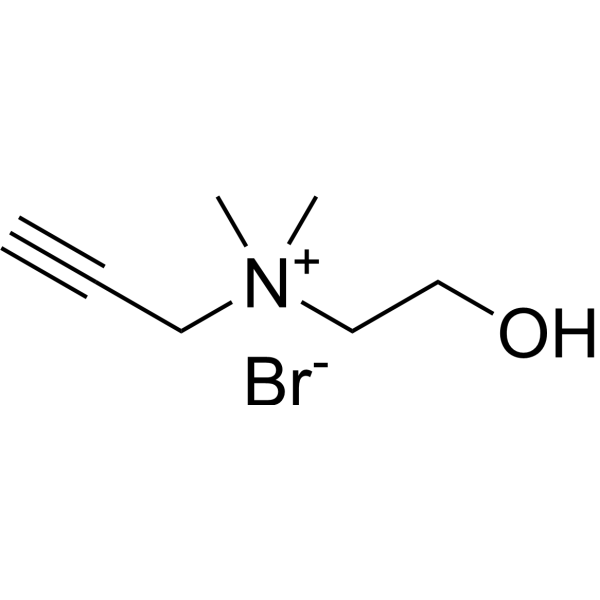
Propargylcholine
CAS No. 111755-76-1
Propargylcholine( Propargylcholine (bromide) )
Catalog No. M28160 CAS No. 111755-76-1
Propargylcholine is an alkyne-modified choline analog and inhibits choline catabolism at the level of Dgc enzyme-catalyzed dimethylglycine demethylation in Pseudomonas aeruginosa.
Purity : >98% (HPLC)
 COA
COA
 Datasheet
Datasheet
 HNMR
HNMR
 HPLC
HPLC
 MSDS
MSDS
 Handing Instructions
Handing Instructions
| Size | Price / USD | Stock | Quantity |
| 10MG | 37 | Get Quote |


|
| 25MG | 82 | Get Quote |


|
| 50MG | 133 | Get Quote |


|
| 100MG | 254 | Get Quote |


|
| 200MG | Get Quote | Get Quote |


|
| 500MG | Get Quote | Get Quote |


|
| 1G | Get Quote | Get Quote |


|
Biological Information
-
Product NamePropargylcholine
-
NoteResearch use only, not for human use.
-
Brief DescriptionPropargylcholine is an alkyne-modified choline analog and inhibits choline catabolism at the level of Dgc enzyme-catalyzed dimethylglycine demethylation in Pseudomonas aeruginosa.
-
DescriptionPropargylcholine is an alkyne-modified choline analog and inhibits choline catabolism at the level of Dgc enzyme-catalyzed dimethylglycine demethylation in Pseudomonas aeruginosa.
-
In VitroPropargylcholine bromide (10, 50 μM; 24 h) incorporates into NIH 3T3 cells and shows strong staining in a concentration-dependent manner (fixed and stained with Alexa568-azide). Immunofluorescence Cell Line:NIH 3T3 cells Concentration:10, 50 μM Incubation Time:24 h Result:Showed strong staining proportional in intensity to the concentration of added Propargylcholine bromide.
-
In VivoPropargylcholine bromide (P-Cho; 3.5-4.0 mg/kg; i.p; single daily for 6 days) effectivelyincorporates into newly synthesized myelin within 1 week of dosing and sustained presence beyond 6 weeks in rhesus monkey.
-
SynonymsPropargylcholine (bromide)
-
PathwayGPCR/G Protein
-
TargetAntibacterial
-
RecptorBacterial|PGE2|COX-1|E. coli
-
Research Area——
-
Indication——
Chemical Information
-
CAS Number111755-76-1
-
Formula Weight208.099
-
Molecular FormulaC7H14BrNO
-
Purity>98% (HPLC)
-
SolubilityIn Vitro:?H2O : 125 mg/mL (600.67 mM)
-
SMILES[Br-].C[N+](C)(CCO)CC#C
-
Chemical Name——
Shipping & Storage Information
-
Storage(-20℃)
-
ShippingWith Ice Pack
-
Stability≥ 2 years
Reference
1.Zhou Yin,et al. DNA replication is the target for the antibacterial effects of nonsteroidal anti-inflammatory drugs. Chem Biol. 2014 Apr 24;21(4):481-487.
molnova catalog



related products
-
NXL101
NXL101 is a novel quinoline bacterial DNA gyrase and topoisomerase IV inhibitor that shows potent activity against gram-positive bacteria.
-
Amifloxacin
Amifloxacin is a synthetic antibacterial compound and showed moderate activity against Staphylococcus aureus, with MICs of less than or equal to 2 micrograms/ml.
-
AU-1235
AU-1235 is a novel, specific mycobacterial membrane protein large 3 (MmpL3) inhibitor.



 Cart
Cart
 sales@molnova.com
sales@molnova.com


